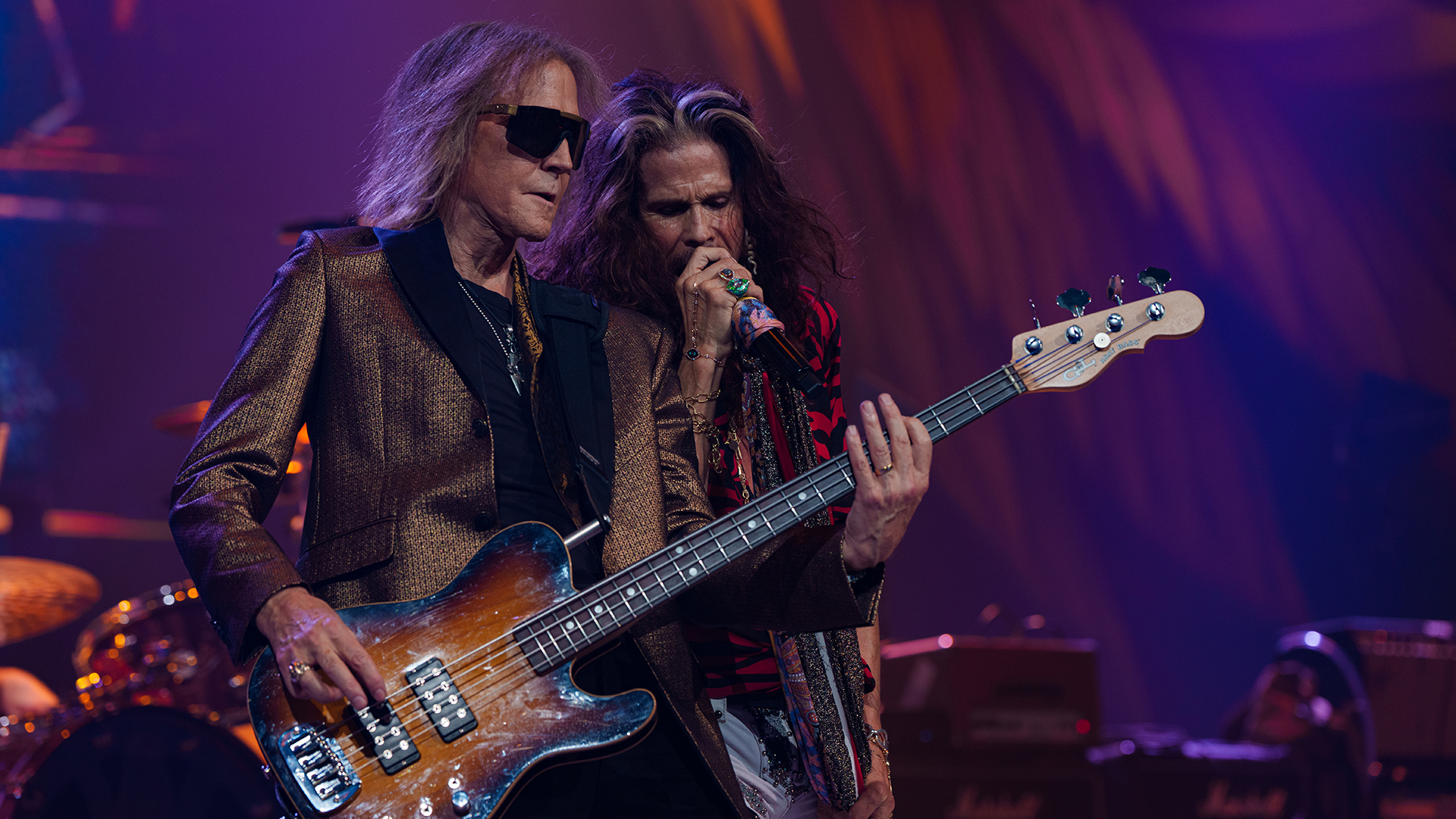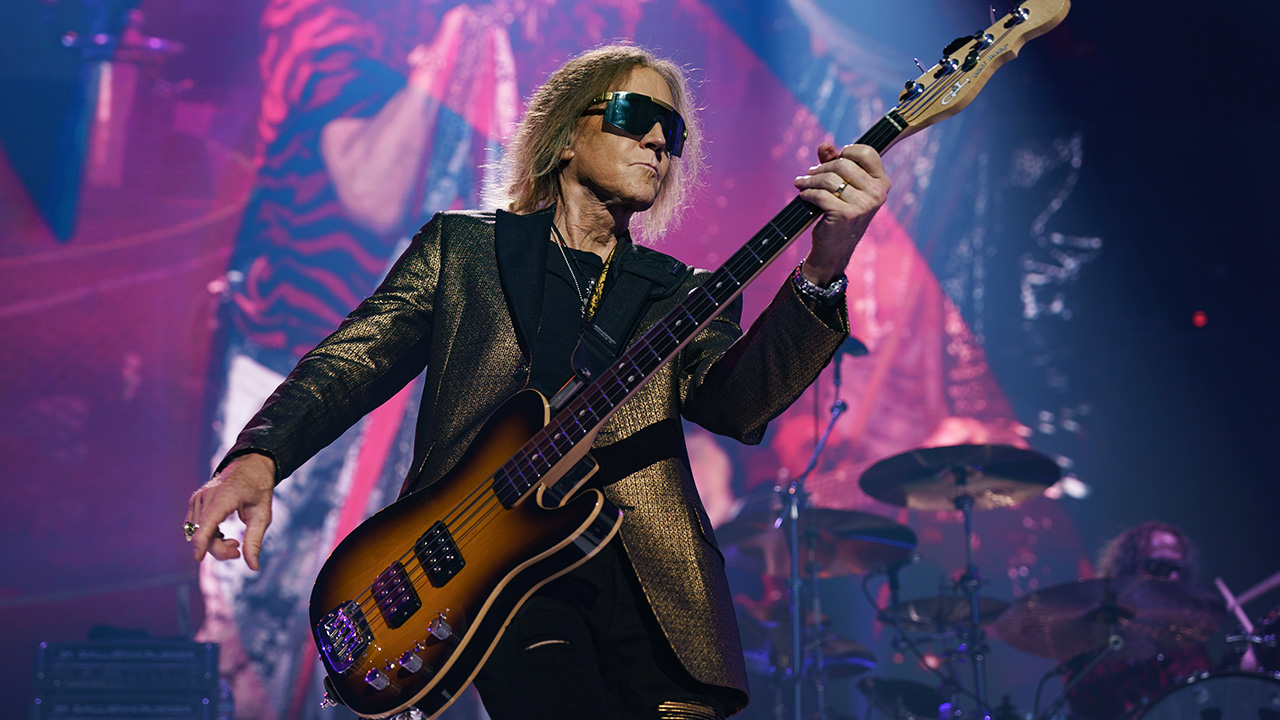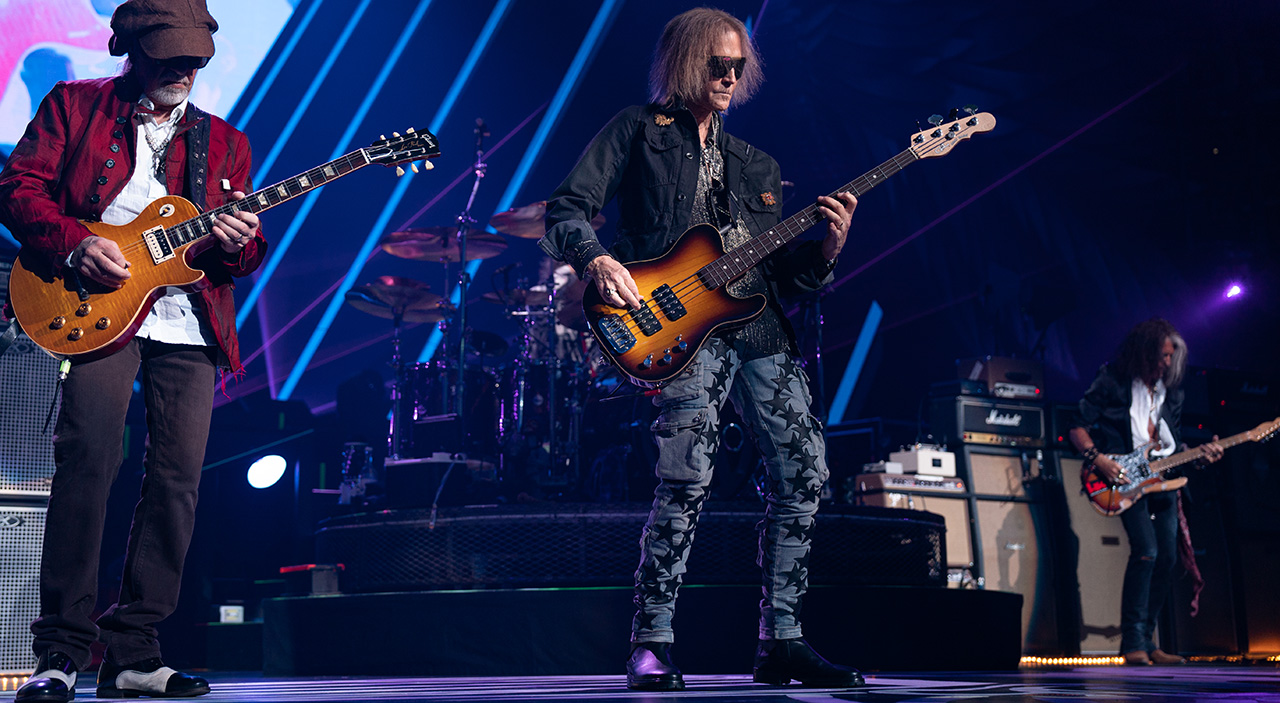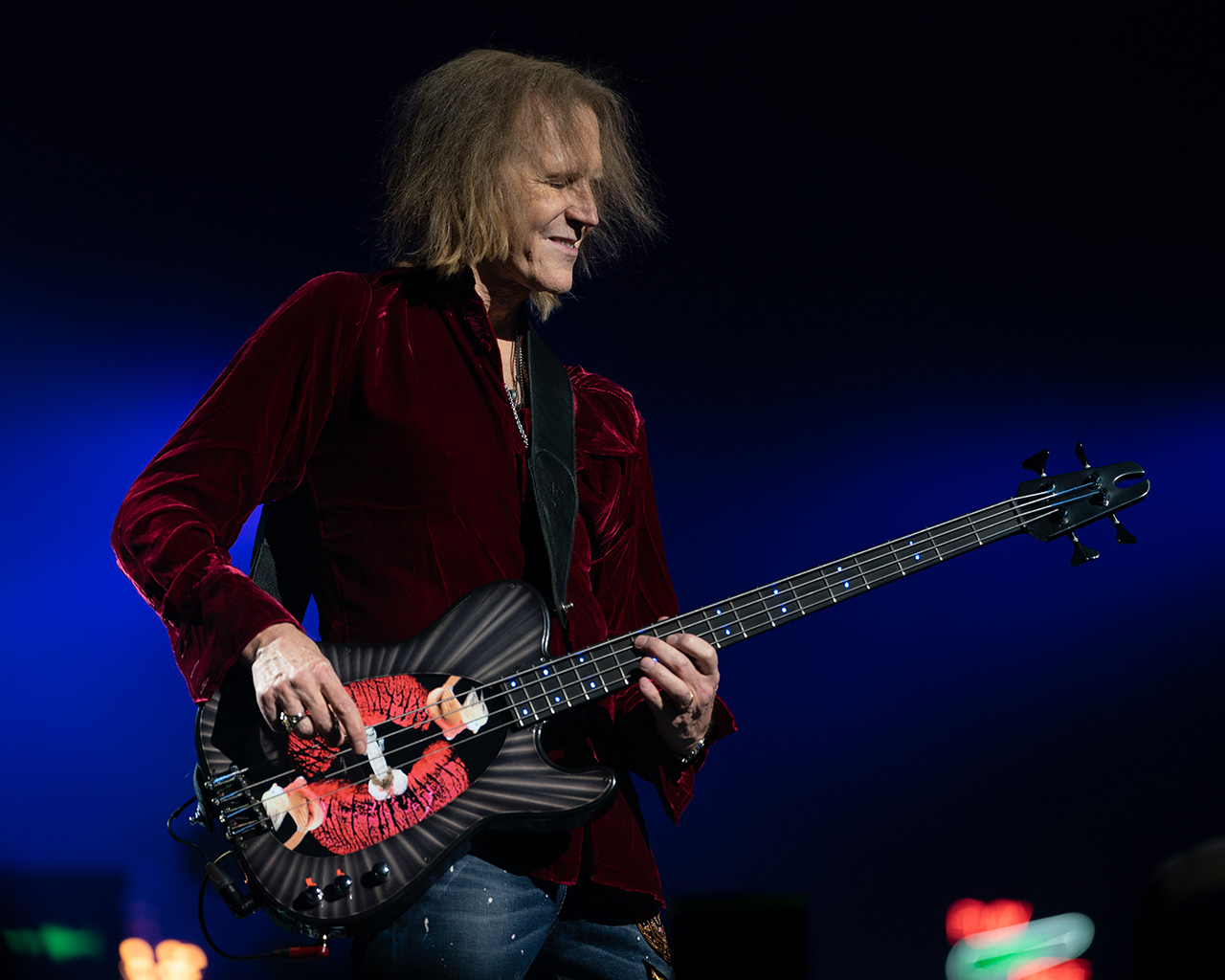“We put out Rock in a Hard Place and went out on the road, which was the definition of the word ‘fiasco.’ Too many shows ended early due to the excessive use of chemicals”: Tom Hamilton on Aerosmith’s past challenges – and why they still have a future
Still finding inspiration, he explains how close the band came to missing out on Sweet Emotion, his near-grudge over Janie’s Got a Gun, why he was glad Joe Perry quit and the development of his video screen bass

Steven Tyler affectionately refers to Tom Hamilton, Aerosmith’s bassist since day one, as “Mr. Sweet Emotion” – evidence that his grooving bassline from the the band’s 1975 classic track is one for the ages.
But to boil his accomplishments down to just that piece would be a disservice. Hamilton played guitar on classics like Uncle Salty and Sick as a Dog from Toys in the Attic and Rocks, respectively, and co-wrote Janie’s Got a Gun from Pump.
Aerosmith ground to an unexpected halt on September 9, 2023, when Tyler fell throat-first into the onstage railing at Elmont, New York, three songs into the show. But no one knew it was over at the time; the singer powered through another 15 songs – and a late-night rendition of Happy Birthday for Joe Perry.
But when the singer found he was struggling to breathe and speak, let alone sing, the Peace Out farewell tour was postponed. It was slated to re-start on September 20, 2024, but on August 2 the band announced its cancelation, with Tyler unable to fully recover from his injury.
Based on his guest spot with the Black Crowes earlier this year, it’s apparent that Tyler can still sing. But the concern must be that the 76-year-old won’t hold up to the rigors of 20-plus songs a night for months on end. Of course, the entire Aerosmith team is devastated.
“We had an amazing crew,” Hamilton tells Bass Player. “And so many people who put in everything they had, from our management and production designers to the video directors, sound and lighting people and… well, I could go on and on.”
But he adds: “As far as the career goes, I refuse to consider it over. There are a lot of things we could do in the future. We’ll just have to see once we get out of reaction mode and back to creative mode. I’m going through a phase now where I can feel my playing taking a step upward. Inspiration is always right around the corner.”
Get The Pick Newsletter
All the latest guitar news, interviews, lessons, reviews, deals and more, direct to your inbox!
Hamilton is working on new music with a new group, to be revealed soon. Meanwhile, he says of Aerosmith: “I find it hard to believe that we'll never play again. I’ve been surprised by things that have happened with this band too many times to think that the future is closed.”

It must have been painful to cancel the farewell tour.
“I was surprised but not shocked when I got the news. When Steven fell, he hit his larynx on a railing and fractured it. I still can’t believe he finished the show. It’s not the first time he’s had an injury during a show and powered through it. I know how hard he worked on healing and working on getting ready to go on the road again – but it just wasn’t possible.”
Can you give some insight into the state of Aerosmith now?
“It was a punch in the gut finding our touring days are over. Maybe someday we can do something again, but it won’t be a tour. I’ve been keeping busy playing in a band we’re calling Close Enemies. We’ve recorded a bunch of killer songs and we’re getting closer to deciding how we’re going to put it out. Can’t wait!”
What are your overarching thoughts when you look back?
“My Aerosmith bandmates and I are still in reaction mode. It’s hard going online and seeing all the other bands out there, but I try to keep myself from dwelling on it and letting myself go to a dark place inside. It’s painful thinking about all the fans who were waiting to come see us. I’ll always be grateful to them for being there for us.”
From a bass perspective, how do you measure your accomplishments?
“I only think of it as a prelude to what I want to be as a musician. I’ve never been satisfied with where I was at as a bass player. There are a lot of things I wish I did to get ahead musically. I know I contributed a lot to help make this band cook. It’s not just about musicianship. I’m proud of the fact that I always wanted to be a good band member – a good teammate. I was always wanting to get better and contribute more.”

What’s the secret sauce to your bass tone?
“I’m still searching for that perfect tone I hear in my head. I think it’s buried somewhere in my technique – it’s in my fingers somewhere. I don’t spend a lot of time listening to Aerosmith albums, but sometimes when I happen to hear one of our old songs, I realize I’ve always been closer than I thought, and it pleasantly surprises me.”
As far as effects, do you have a tried-and-true recipe?
“I’m not a big effects user, but I do use a few things. One is a 3 Leaf Audio Octabvre octave pedal for thickness. I’m constantly trying out distortion pedals. I think the Origin Effects BassRIG is one of the best I’ve ever had. I use in-ear monitors, and that pedal gives me a nice, juicy sound. I pretty much leave it on.
Pretty soon I had the basic arrangement for Sweet Emotion… I was just too musically shy to try and get everybody’s attention
“When we were doing the Vegas residency, I dipped my toe into the Fractal world. After a while, all my distortion and chorus sounds came from the Fractal. I use different effects for my in-ears and my stage sound. For those last three shows, I tried putting an SVT up there; I used it alongside the Gallien Kruegers, and I got some major fatness.”
How did you come up with that Sweet Emotion bassline?
“I’m always looking for that perfect balance between clarity and crunch. That opening riff came along sometime between our first and second albums. I was practicing one day, just thinking of exercises to get my hands warmed up.
“When I’m in that mode and I get my hands nice and loose, there’s a flow that happens. It’s like I’m sitting by a river and something floats by that gets my attention. I’ll just mentally grab it and keep playing it over and over – and sure enough, something else will float by.”
Did you take inspiration from a particular place?
“There’s a Jeff Beck album, Rough and Ready, that has a lot of really cool, energetic bass playing on it. I was inspired by it and wanted to come up with something with that feeling, and that’s where I got the interludes between the verses.
“Then, at some point, I picked up my guitar and came up with the guitar part in the verses. Pretty soon I had the basic arrangement. But I was just too musically shy to try and get everybody’s attention on it.
“When we were recording the basic tracks for Toys in the Attic, we wound up finishing a day early. Our producer, Jack Douglas, said, ‘Anybody have a riff we could play around with?’ I kind of put my hand up. Jack got everybody together and I showed everybody what I had – and by the end of the day we had a basic for it.”

You played guitar on Uncle Salty and Sick as a Dog. What gear did you use?
“I used a Fender Strat to write the guitar parts for that Uncle Salty, and then when we did Rocks, I came up with Sick as a Dog on a Fender Esquire. I love Teles and Esquires.”
Many say Rocks is Aerosmith’s best album – do you agree?
“I’d have to agree it’s the album that defines us. I’d say it’s virtually neck and neck with Toys. Both of those albums were a friggin’ blast to put together. Working with Jack was really fun and exciting. He and the band were very much into experimentation, and you can really hear that with those records.”
We gathered in a dressing room and everything exploded… I just wanted to be free of all the conflict. I was actually glad it happened
How do you look back on the tough period of the late ’70s?
“By the time we started work on Draw the Line, drugs were becoming more destructive. I don’t consider that a great Aerosmith album, although a lot of people really like it. It definitely has some great moments on it.
“Then came Night in the Ruts. It was actually a step in the right direction, but by that time, the band was starting to fall apart. We were only partway finished with that record and we had to go on the road. A tour had already been booked and we couldn’t put it off.

“There was a lot of anger building up, and it came to a head during that tour. We were doing stadiums, but we let the bad feelings overtake our ability to appreciate what we had. The result was Joe and the rest of us parting ways.”
Do you remember Joe’s departure?
“I think we’d just played Cleveland Stadium to a huge crowd. We gathered in a dressing room trailer and everything exploded. I knew there was no point in trying to talk it out. I just wanted to be free of all the conflict.
“I was actually glad that it happened. Joe went off and did solo projects, and the we found Jimmy Crespo, who was an excellent guitarist and writer. We all set up shop in New York and started work on an album. We got work done – but just barely.”
Is that what led to Brad Whitford leaving?
“Brad finally got sick of the madness and took off. The rest of us kept working and finished Rock in a Hard Place. Jack suggested we replace Brad with a lovable madman named Rick Dufay – who was just this side of being out of control, but he contributed a lot in a crazy way.
“He helped out musically and added a lot of personality into the mix. We put the album out and went out on the road, which was the definition of the word ‘fiasco.’ Too many shows ended early due to the excessive use of chemicals.”
At the time, could you have imagined that Joe and Brad might return?
“Ironically, Rick regularly told us how crazy we were to not put our band back together – a suggestion that would have left him without a job! During the next few years, I’d hear talk about getting Steven and Joe to get back together, but I knew it would have been back to the same old nightmare.
Steven’s song included the bass riff from the thing I had brought in … I decided to be a good soldier and keep my mouth shut
“It took a couple more years before everybody really got in touch with what we had lost. Joe’s solo career wasn’t doing what he’d hoped, and Aerosmith was going nowhere. Finally, everybody realized it was time to put the past where it belonged.”
Did it surprise you that after Joe and Brad returned, Aerosmith became bigger than ever?
“We went out on the road, and it was rough, but it worked. We recorded Done with Mirrors, but it wasn’t until we did Permanent Vacation that things really took off. We worked with Bruce Fairbairn as producer – he really brought some structure into the recording process.”

Some fans say Aerosmith’s albums with Bruce are the best, even if they were different-sounding than the ‘70s albums.
“We made three albums with Bruce: Permanent Vacation, Pump and Get a Grip. We had a manager who got us to realize that things were changing in the radio world and convinced us to take advice from an amazing A&R guy at our new record company.
“Grunge was starting to happen in a big way and radio stations that used to play us started going the other way. It was time to try to have some hit singles. In my mind, those three albums were the perfect combination of rocking out and having hits. I’m really proud of all three of those albums, but especially Pump. We took some big chances but still stuck to making rock records we were proud of.”
You co-wrote Janie’s Got a Gun – a big hit from Pump.
“I brought in a demo of a song idea that had an intro that combined harmonics with a climbing riff on the E string. I drove home that day feeling pissed that nobody took notice of it! About a month later, Steven came to the studio one day with Janie’s Got a Gun. He sat down at a keyboard and played and sang the whole song – finished.
“We were all blown away, but I was a little perplexed; his chord progression sounded awfully familiar. It included the bass riff from the thing I had brought in a few weeks before. I fought with my emotions, trying to decide if I should make an issue of it. I decided to be a good soldier and keep my mouth shut. It was a Steven Tyler song, even if it included that piece of my song in the intro.

“A couple of months later, I was back in Boston and Steven and Joe were still in Vancouver mixing. One day, Steven called me out of the blue and said, ‘Hey, I’m putting your name on Janie’s Got a Gun.’ I was so relieved because I was still sitting on some anger about it! Sometimes things work out nicely.”
Do you hold Get a Grip – arguably Aerosmith's biggest record – in the same regard as the classic ‘70s records?
“I can’t say Get a Grip is my favorite Aerosmith album. But Livin’ on the Edge has always been one of my favorite songs to play live. The hit singles that became hit videos on that album helped pave the way for us to spend the next 30-plus years rocking out onstage. Plus, now we had girls in our audience!”
After the mega success of Get a Grip, Aerosmith tapered off in the studio. Why?
“We went for a long time without making records. Don’t ask me why. We just enjoyed being about the road and playing live. No excuses; it’s just the way things worked out. We were busy with rollercoasters!”
What album would you call out as Aerosmith's most underrated?
“I’d have to say Rock in a Hard Place. It’s a mess, but it has a lot of cool moments.”
Why have you chosen to play G&L basses over Fender?
When I started playing G&Ls, it wasn’t a matter of them versus Fender; I love Fender basses. But I needed something with a narrower neck than a P-Bass. I’ve always been into Jazz Basses, but I was ready for something different.
“The ASAT neck is just right in my personal Goldilocks story. Plus, I liked the active electronics – I think that was the main thing. I had a period when I played Music Mans; I still love those things. They’re all Leo Fender’s inventions.”
When did you discover G&L?
“I had an amazing tech for 15 years who had a gorgeous black ASAT. He let me use it, and the more I played it, the more I liked it. I had a period starting in the ‘90s when I started playing Sadowskys. They’re really nice guitars – like Super Fenders. I have a five-string that I got back then, and I’ve played it in every show the band has done since then.”
I consult my uber tech on gear questions. He recommends things, and if they sound good I keep them
You’ve got a signature model with G&L that’s flown under the radar.
“I do have a signature model ASAT; I don’t think too many people know about them. One day I was whining about how heavy they were, so they made me a couple of custom instruments. One was made out of pine and the other was made of the same wood as the production versions, but with a lot routed out. They both sound amazing.”
In addition to G&L, you’ve been playing a funky bass with a cool display during Sweet Emotion. What’s that?
“It’s called a Variax Bass 700, and it’s made by Visionary Instruments. Most of the front face is a video screen. Years ago, I used to stick video iPods to the front of whatever bass I was using. I reversed the screen so whoever was looking at them would see themselves.

“I thought it would be kind of funny to take the bass out on the thrust at the beginning of Sweet Emotion – the people in the audience could see themselves when they looked at the bass.
“This company found out about it and sent me a bass they had designed that had a video screen on it. My tech could put whatever footage we could scrounge up on it. The company kept improving how it looked and played. We could put comedy footage on it or flashy outer space stuff. Pretty cool!”
How has your rig shifted over the years?
“I consult my uber tech, Trace Foster, on gear questions. He recommends things, and if they sound good I keep them. In the early days I used SVTs, but the sound man complained that because of the cabinet design, the full volume of the amp doesn’t happen until the 20th row, making it hard to mix.
“I took him at his word and started trying other gear. After a while, I tried a Gallien Krueger rig and really liked it. It was easy to get a fat, punchy tone. In my band, the percussive, clearer sound was what worked, so I’ve stuck with them ever since. I use the Fusion 550 heads with four of the 4X10 cabinets. I’ve had great luck with them – a good company!”
Andrew Daly is an iced-coffee-addicted, oddball Telecaster-playing, alfredo pasta-loving journalist from Long Island, NY, who, in addition to being a contributing writer for Guitar World, scribes for Bass Player, Guitar Player, Guitarist, and MusicRadar. Andrew has interviewed favorites like Ace Frehley, Johnny Marr, Vito Bratta, Bruce Kulick, Joe Perry, Brad Whitford, Tom Morello, Rich Robinson, and Paul Stanley, while his all-time favorite (rhythm player), Keith Richards, continues to elude him.
“I’ve never bought a guitar and I’m quite proud of that! I always tell people when they’re learning: there’s a guitar not being played”: Meet Sacred Paws’ Ray Aggs, the dextrous Tele-wrangler inventing new chords and capturing Thurston Moore’s imagination
“Even standing with the guitars is tricky”: Ritchie Blackmore's health sparks concern after update from wife and musical partner Candice Night








![[from left] George Harrison with his Gretsch Country Gentleman, Norman Harris of Norman's Rare Guitars holds a gold-top Les Paul, John Fogerty with his legendary 1969 Rickenbacker](https://cdn.mos.cms.futurecdn.net/TuH3nuhn9etqjdn5sy4ntW.jpg)





